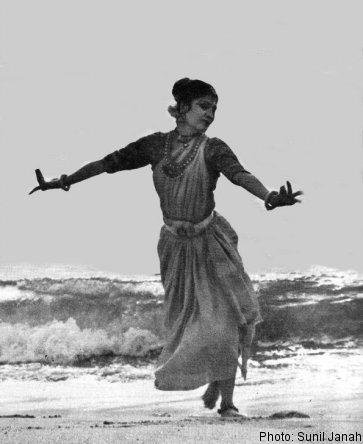 |
  |
 |
  |
In praise of Shanta Rao - Sanjeevini Dutta, UK e-mail: sanjeevini@pulseconnects.com January 30, 2010  One of my most treasured possessions is a brown canvas bound book with orange lettering titled Dances of The Golden Hall. It has pride of place in the glass cabinet of my dance studio. This book has contributed significantly to my lifelong commitment to Indian dance. Yet I have never met the dancer or seen her perform live or even in film. My relationship to her is through images that have captured my imagination for the past forty years. That dancer, who sadly never knew that she had inspired such devotion, is Shanta Rao. The photographs in the book, Dances of The Golden Hall, are taken by Sunil Janah, between 1962 and 1965 when Shanta Rao would have been at her peak. They capture a powerful presence: strong, dynamic and passionate. I am puzzled to read the controversy that she aroused on account of her Kathakali background, making her some critics thought 'un-feminine.' The very quality that attracts a modern feminist such as myself, is the strength and power she exudes. Even as the 'enchantress,' she is unique in forgoing seduction through sidelong glances. I would imagine her approach to her lover would be direct and forthright. There is an extraordinary set of photographs taken by Sunil Janah on the beach in Mahabalipuram. Backlit against the sea in invocatory poses, in flight or in meditation, the images capture the essence of dance: the eternal rhythm of the tides, the rising and setting of the sun, the movement and the stillness within. There is an image of Shanta, with her back to the viewer left leg extended, head in profile, almost a silhouette, the scant light catches her silver belt, the little sparkles in her blouse, and a white veni snaking through her long braid ending just below her buttocks - a veritable picture of kundalini rising. Looking at Shanta's photographs has nourished me as an artist and human being over many decades. They have set a standard of discipline, devotion but also of aesthetic refinement. Her choice of costume and jewellery has simplicity and style. One can imagine her uncompromising standards in all aspects of her art. It is sad that Shanta became a recluse and we did not get an opportunity to watch her perform or interact with her. However she touched many including the likes of Pandit Nehru and Yehudi Menuhin. I am grateful to her biographer Ashoke Chatterjee, photographer Sunil Janah and to the ICCR for creating this precious legacy for future generations. Note for readers: Shanta Rao (1925-2007) trained in Kathakali at Kalamandalam, the first female pupil to have that distinction, followed by an initiation into Mohiniattam by Guru Krishnan Panniker and finally in Bharatanatyam under Meenakshi Sundaram Pillai. Book 'Dances of the Golden Hall' published by 1CCR, 1979. Sanjeevini Dutta trained in Odissi in Bombay with Guru Shankar Behera. In the UK since 1983, Sanjeevini has played many roles in promoting Indian dance through workshops, performances and in her capacity of Director of Kadam, a dance agency based in Bedford. She is currently the editor of Pulse, a dance quarterly with the mission of connecting South Asian dance and music communities worldwide. |